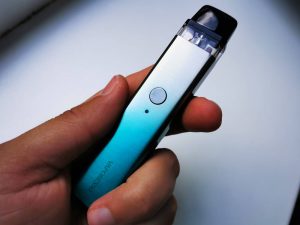E-Liquid Ingredients Mix to Create New, Harmful Chemicals, Heavily Contested Study Claims
There’s a new vaping study going around claiming once again that vaping is very dangerous, this because the ingredients in e-liquid mix when vaporized and create new and harmful compounds.
 Published by researchers at Duke University, in North Carolina, the study suggests that chemicals produced by e-cigarettes combine inside user’s lungs to create entirely new compounds that appear to be harmful to human cells. Authors reached this conclusion after exposing epithelial cells that line the human bronchi to e-cigarette vapor obtained from various flavored e-liquids. Tested ingredients included flavorings like vanillin, ethyl-vanillin, benzaldehyde, cinnamaldehyde, and the standard e-liquid bases, propylene glycol and vegetable glycerine.
Published by researchers at Duke University, in North Carolina, the study suggests that chemicals produced by e-cigarettes combine inside user’s lungs to create entirely new compounds that appear to be harmful to human cells. Authors reached this conclusion after exposing epithelial cells that line the human bronchi to e-cigarette vapor obtained from various flavored e-liquids. Tested ingredients included flavorings like vanillin, ethyl-vanillin, benzaldehyde, cinnamaldehyde, and the standard e-liquid bases, propylene glycol and vegetable glycerine.
Professor Sven-Eric Jordt, lead author of the study, and his colleague found that above-listed ingredients tended to mix and form unstable compounds which could harm and even kill lab cells. Researchers declared themselves surprised to see that these new compounds could irritate receptors in nerve endings linked to the heart and blood vessels, and in some instances be able to kill the epithelial cells.
“We consistently observed that the new chemicals formed from the flavors and e-liquid solvents were more toxic than either of their parent compounds,” Professor Sven-Eric Jordt, a associate professor of anesthesiology, pharmacology and cancer biology at Duke University School of Medicine, said. “The new chemicals derived from benzaldehyde and cinnamaldehyde were more toxic than the vanillin-derived compounds.”
“Activation of sensory irritant receptors can increase the heart rate and, in predisposed people, can lead to an irregular heartbeat and higher blood pressure. It can also increase secretions in the nasal passages and throughout the lungs and airways, leading to coughing and breathing difficulties,” Prof. Jordt added.
Authors also mentioned that the harmful chemicals appeared to disrupt the structures inside living cells, thus preventing them from carrying out their normal function. For example, an analysis of the mitochondria showed that these new chemicals suppressed both the ability of mitochondria to consume oxygen and the production of adenosine triphosphate, a chemical that provides energy for several cellular processes.
“Our findings suggest that e-cigarettes release unstable chemical mixtures containing a large variety of chemical products with unexpected toxicological properties,” the study authors concluded. “Regulators need to be made aware that these compounds can form so that toxicology studies can be initiated to evaluate their safety. They should conduct or fund additional research on the fate of chemicals in e-liquids, and especially their toxicology.”
The findings of this study have already been propagated on the internet as facts, but to many in the industry they came as a shock, as no one has ever raised such concerns about vaping before. We all knew about the toxic compounds formed through high temperature vaporization (acrolein and formaldehyde being the most talked-about), but now we have these new, unstable toxins resulted from mixing various flavors with vegetable glycerin and/or propylene glycol?
While I have yet to see any feedback from US scientists and vaping activists on this research, things are a bit different in Europe, where both vaping associations and researchers have been contesting the study and its findings, and have even gone as far as petitioning the European Respiratory Society not to present the research during next week’s online congress.
Italy’s National Association of Electronic Cigarette Consumers was among the first to react to this study, accusing its authors of prejudice towards vaping and of generalizing in order to make it seem that all e-liquid was dangerous, despite only testing a few of them. It also asked the European Respiratory Society to withdraw the Duke University study from the congress discussion due to an evident conflict of interest with the tobacco companies.
In case you didn’t know, Duke University has been linked to Big Tobacco since its inception. It was named after one of the largest tobacco producers in US history, James Buchanan Duke, and there is even a statue of him smoking a cigar on university grounds. But the ties to Big Tobacco go deeper. In 2004 the Duke University Medical Center announced the creation of a new research center on nicotine and smoking cessation financed through a $15 million grant from Phillip Morris International (out of the goodness of their heart, I’m sure).
of the largest tobacco producers in US history, James Buchanan Duke, and there is even a statue of him smoking a cigar on university grounds. But the ties to Big Tobacco go deeper. In 2004 the Duke University Medical Center announced the creation of a new research center on nicotine and smoking cessation financed through a $15 million grant from Phillip Morris International (out of the goodness of their heart, I’m sure).
At the head of the above-mentioned research center the University name one Jed Rose, a famous inventor and nicotine researchers known for his contribution to the invention of the nicotine patch. He also worked on early tobacco-heating technology used in devices like the IQOS, and later sold that technology to Phillip Morris.
“I have accepted research funding from the tobacco industry, under conditions that provide transparency and oversight to ensure research integrity, and am currently a paid consultant to Philip Morris International, specifically to support the development of reduced risk products,” Prof. Rose’s biography on the Duke University website reads.
It is for conflicts of reasons such as these that several associations and media organizations have requested that European Respiratory Society not present this study at next week’s congress.
But it wasn’t just people in the vaping industry voicing their concern about the findings of this study, but other researchers and public health experts as well.
“The data presented here concerns in vitro cell work and not human clinical studies, therefore, any extrapolation to the whole system of human physiology is weak at best,” Jacob George, professor of Cardiovascular Medicine and Therapy at the University of Dundee, Scotland, said. “Importantly, no one should claim that e-cigarettes are completely safe. In an ideal world we shouldn’t be inhaling anything other than oxygen. However, as a comparative risk, they contain far fewer harmful chemicals than the 8,000 chemicals in traditional tobacco cigarettes, among which chemical interactions we have not even been able to fully understand.”
Nicholas Hopkinson, medical director of the British Lung Foundation and lecturer in Respiratory Medicine at Imperial College London, also shares his colleagues opinion that the Duke University study should have included a comparison to tobacco cigarette smoke, as vaping is regarded as a safer alternative to smoking, not a harmless, 100% healthy habit.
Conference abstract reports as “a discovery” the formation of novel “toxic chemicals in e-cigs from the reaction between ingredients–alcohols (PG, VG)+aldehydes (vanillin, benzaldehyde)=acetals. What a discovery! Attached photo of a 1933 paper about it!https://t.co/yfZlWTEJSA pic.twitter.com/9XcIsqmlWA
— K. Farsalinos (@FarsalinosK) September 3, 2020
“Since these studies do not provide information on concentrations relative to those observed in cigarette smoke, it is not clear what significance the results have,” Hopkinson said. “No serious scientist can claim that vaping is completely safe, however it is much less dangerous than smoking because the toxic chemicals in tobacco smoke are absent or are present at much lower concentrations in e-liquid vapor.”
Finally, Professor Konstantinos Farsalinos, one of the world’s most experienced researchers in the field of vaping and electronic cigarettes, took to Twitter to mock Sven-Eric Jordt and his colleagues for their ‘discovery’, claiming that this information has been known since the 1930’s.
Sadly, despite the questions and controversy surrounding this study, its findings are being presented as facts by many mainstream media outlets and even scientific organizations like the European Respiratory Society. Under these circumstances, it’s easy to see why the general public now considers vaping just as or more harmful than smoking tobacco.
Top photo: Nery Zarate/Unsplash
















